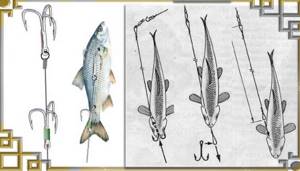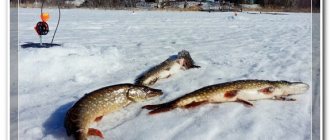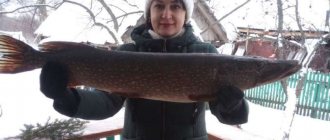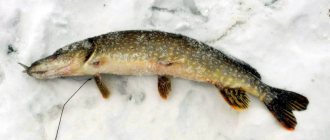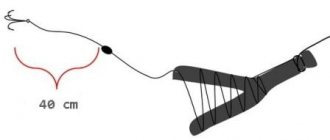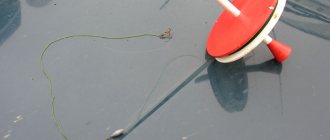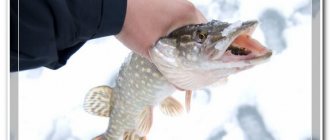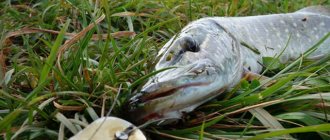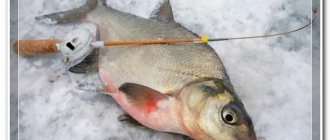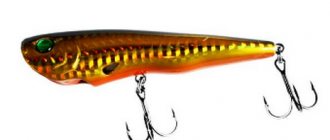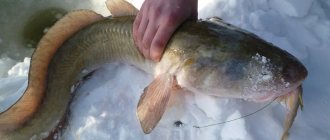Fishing for pike on girders is the most popular type of fishing in winter. This method is more effective, unlike trolling or fishing with a jig, since if you install gear in several places, it increases the catch. The main thing is to know the secrets of fishing and the places where pike are found in winter.
The most productive time for pike fishing in winter: on the first and last ice. At this time, the predator is actively looking for food and it will definitely respond to the live bait offered by our zherlitsa.
Types of girders for winter pike fishing
Let's consider the types and designs of winter vents. Today there are 3 types of girders known, which differ from each other both in the type of placement and equipment. Let's look at the advantages and disadvantages of each.
Platform
It is a square or round base made of plastic or, less commonly, wood, with a diameter of approximately 25 cm. The vent is installed on a hole, it is very easy to mount, it needs to be secured against the wind.
Advantages:
- The water in the hole freezes more slowly, since it is protected from the wind by the base of the girder, so the fishing line will be easy to unwind and reel in.
- The hole is covered with the base of the girder and the fish are not afraid of the sun's rays.
Flaw:
- Not compact;
- It often breaks because it freezes into the ice and is removed with breakage;
- We have to install signals, because when it snows, it quickly gets covered with snow;
Not recommended for fishing below -10 C, the fishing line will freeze.
Conclusion: A platform girder is often chosen because it is easy to find in a store and easy to install with minor flaws.
Watch the video: Catching pike in winter on a girder
On one pole
Advantages:
- Cheaper than a platform girder.
Flaws:
- To install you need snow, snow is a guarantor of stability;
- The material is metal, your hands freeze when you install it;
- It is not entirely stable, since the stand heats up in the sun, the snow melts and the stand falls;
- The open hole is often covered with ice.
Conclusion: cheaper in cost compared to the platform one, but there are more disadvantages.
Taganok (perch on a tripod)

Often it is an aluminum or plastic tripod with a coil. Often there is already a signal pole.
Advantages:
- Convenient for transportation, folding design.
Flaws:
- The structure is unstable in the wind;
- The base is often metal, so your hands freeze;
- When biting, the legs may fold and the girder may drown.
Conclusion: there are more disadvantages than advantages.
Watch the video: Review of winter vents
Video
Pike fishing in winter - spinning on a small river video
Another video of my fishing, this time with winter spinning and pike fishing in winter. The scene is one of the small rivers of my region.
Pike on a spinning rod in winter in open water video
Many reservoirs in southern Russia do not freeze even in the depths of winter. Alexey Shanin will tell you how to catch pike with a spinning rod.
Choosing a priest
Coil
It is better if your choice is a plastic reel with a difficult move, so that if you are a fan of frosty fishing, it is comfortable to hold in your hands, since it is non-metallic and so that the fish does not quickly feel the movement of the fishing line and does not let go of the prey. You should also choose a reel so that there is enough space for fishing line, so that if the need arises for fishing at depth.
Important! The gasket, which is located between the coil and the nut pressing it, allows you to correctly adjust the rotation of the coil. A properly tuned reel should make 6-7 revolutions and stop.
Bite alarm
It is better to choose a flag that is bright green, red, or orange, so that it can be seen from afar. The alarm itself can be taken 45-55 cm long with medium elasticity, so that it can withstand the jerks of live bait and trigger bites.
If you are a fan of night fishing, choose fluorescent flags.
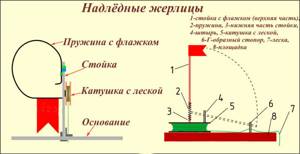
Correct equipment for winter fishing
- fishing line;
- sliding sinker;
- sinker stopper;
- swivels with clasps;
- leash;
- tee.
An example of a platform girder diagram in the figure.

Assembling the bait itself will not be a special secret or difficult, but choosing the right equipment and planting live bait, and most importantly, choosing the right habitat for a hungry predator, this is the main secret.
fishing line
For winter fishing for pike on a girder, you should prefer a monofilament and elastic fishing line 18-22 m long, so that when quickly unwinding it does not collapse with a spring.
The thickness of the fishing line is 0.35-0.45 mm. This thickness will allow you to catch large catches.
Advice! And it is not advisable to use braided fishing line; it is thinner and freezes quickly.
Sinker
It is necessary to hold live bait at a certain depth.
The shape chosen is oblong.
The weight of the sinker should be approximately 8-14 grams for shallow places, and 16-23 grams for deeper reservoirs.
Advice ! : The weight should be selected experimentally. Too heavy and large a sinker will reduce the amount of catch, the pike will sense resistance and spit out the bait. If the sinker is too light, then the baitfish will be allowed to swim throughout the entire body of water.
Sinker stopper
Mostly in stores you will find rubber fishing stops; they are reliable.
The stopper allows you to regulate the movement of the sinker along the fishing line, and the movement of live bait is adjusted accordingly.
And also with the use of a swivel, the sinker does not break on the swivel.
Hook
on reservoirs without a current, it is better to choose hooks - tees or doubles,
In the current, a single hook will do better.
The most commonly used hooks are numbered 5-8.
Leash
The leash is most often used from a double fishing line. Steel leashes are often abandoned, they reduce the number of bites, they are stiffer, so pike use bait more often.
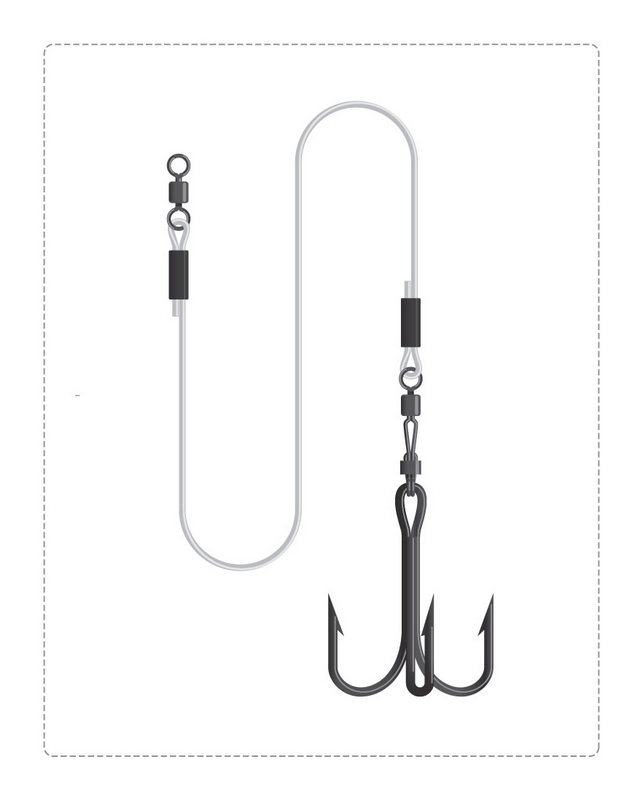
Instructions for making a leash:
- We knit a loop from fishing line 75 cm long.
- The end of the fishing line is folded in half, after which the rounded end is threaded into the resulting loop 4-5 times so that the loop does not get pulled together, after which, holding the place where the free end of the fishing line is located, the loop is tightened, and the knot is slowly adjusted to the free end of the fishing line. The node is called surgical.
- The end of the fishing line should be carefully set on fire.
- A fastener is attached under the loop knot, and a hook is attached to the opposite end.
Search for pike
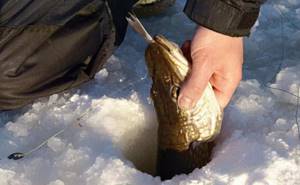
Friends! No matter how much I would like to give a comprehensive answer that can help you accurately find pike sites or indicate hunting routes, this will not be possible. Even seemingly similar bodies of water conceal their secrets and features. There are some rules, in this case you will have to use them.
As stated above, during the period of ice formation, the pike is in a less stressful state than the object of its hunt. This gives anglers the right to enjoy an active bite on the first ice.
Pike adapt perfectly to changing conditions, even when a shell of ice quickly covers the surface of the water. And if the daily temperature fluctuates and the process of ice formation is extended, then this does not particularly affect its behavior.
It is no secret that fresh ice forces peaceful fish to move further from the shore. At depth, the temperature regime is more constant and large groups of fish are provided with a food supply. This is where you should look for an active predator.
The places for such dislocations are edges with sharp changes in depth, areas of washouts at the mouths of rivulets and streams flowing into a larger body of water, at the exits from ponds and lakes into rivers, where holes and whirlpools are often observed. Schools of peaceful fish usually accumulate here in large numbers and, until the ice becomes solid, practically do not move around the reservoir and do not huddle close to the shore.
For example, we have the taiga river Chadobetc, which flows into the Angara. When the surface of the water is covered with ice, just recently the frantic dace rolls into deep water, at the mouth of Chadobets, and stays there for some time in large numbers. Where local fishermen, using nets, harvest dace for the winter.
Of course, there can be no talk of any kind of pike fishing with girders on the first ice. Despite the presence of caulk. It’s just that a similar situation can be observed in small shallow water bodies, where depth differences of one and a half to two meters already have advantages in relation to the general bottom topography. In addition, it is precisely such shallow waters that are the main areas where girdle fish successfully catch pike in the first ice. The ice crust primarily covers shallow bodies of water.
I would question the recommendations to look for pike near the boundaries of aquatic vegetation. Firstly , I was more than once convinced of the absence of hunting pike. Secondly , and most importantly, in the sincere ignorance of peaceful fish in such areas. Probably this is due to a sharp drop in temperature and the inability to feed numerous flocks of dace, sorods, and perches. Or maybe I was simply unlucky.
What else should I add? Pike loves bays, spits bordering the depths, and snags along the coastal dump. It is precisely such areas, found during the season of “liquid” water using a spinning rod, that I primarily focus my attention on. Even if there is a current, it is worth looking for quiet backwaters, protected by protruding dams, bends in the channel, behind islands.
How to bait live bait
We’ll look at how to select and plant live bait below.

Basically, 3 methods of attaching live bait are used:
- Through the operculum;
- Through the back;
- For the lip.
Through the gills
A leash is inserted through the gills of the baitfish so that the hook comes out of the mouth. And the leash comes out under the gill cover.
The pike swallows the bait and calmly swims away, and once it feels the fishing line, it will no longer be able to spit out the bait and stays firmly on the hook. This method is suitable if you leave the bait overnight, but you need to make a longer leash; the pike will cope with the fishing line and have a bite.
We bait live bait through the back
- Between the baitfish's upper body and the spine, this method allows the baitfish to stay alive longer.
- Under the spine.
You need to bait this method more carefully, as you can damage the nerves of the spine and the bait will quickly become immobile.
By the lip
- With light weight tackle and a single hook, use the hooking method - by the lip.
- If there is a strong current, go behind the lower lip; if there is a weak current, go behind both lips.
Watch the video: How to attach live bait for winter pike fishing on girders
Best time of day to fish with live bait
Fishing for girders is not always purposeful. Many ice fishing enthusiasts use postavushas as additional gear, which sometimes brings a good bonus to the main catch in the form of pike. It is advisable to approach toothfish fishing with live bait by going out onto the ice in the evening and staying overnight.
To learn more:
How to choose a bull fishing rod?
In a few hours of daylight, you can identify the most promising points and leave gear there. It is uncomfortable to spend the night on the shore of a winter pond, so you can wait out the darkness either in a car or in a rented house at a nearby recreation center. Checking in the morning usually pays off. It's nice to start fishing by catching a pike. Its activity during the first ice lasts until noon, and in the dead of winter it may be completely absent. At lunchtime, small things up to half a kilogram are mostly caught on the hook. In the evening the bite resumes, but does not last long.

Homemade girder
Fishing technique: how to catch pike on girders in winter
Instructions on how to catch pike on a girder in winter:
- Choosing a location;
- Live bait;
- Fastening the girder;
- Line tightening;
- Attaching the alarm. Adjust so that it shows a bite, but does not react to the twitching of live bait. As soon as the alarm goes up, you need to cut. After hooking, pull out the prey. You may have to drill out the hole if the catch seems large.
If we don’t bite pike, but you have previously caught good specimens in this place, try feeding it with homemade or store-bought bait, or winter bite activators.
Watch the video: Fishing for pike on a girder in winter
Choosing a fishing spot
When and where to catch pike on girders in winter.
Weather conditions are a very important factor when fishing for pike; if the fisherman understands when the pike is biting, you can hope for successful fishing.
When the fish bite:
- On a cloudy day without wind and even when it is snowing - ideal weather for pike.
- On a clear day, the fish will remain on the bottom.
- If the north wind blows, the predator will also not bite.
It’s good if you go fishing to proven places, and even better, baited ones. Then you know exactly where to live. And if not, then listen to the advice of experienced fishermen.
It’s better to look for pike at the end of autumn
- Near the coastline;
- In the thickets of reeds;
- and even better in snags or in pits;
- Edges of the reservoir;
- The best place is where streams flow into the reservoir, where, as a rule, large fish are observed. It’s better to go fishing with a friend; when fighting a predator, you can go under the ice; a friend will help you get onto the ice;
- If there is no bite, you need to check the girders for the absence of bait.
At the end of autumn, it is better to look for pike near the coastline, in reed thickets, and even better in snags. The bulk of the fish will be in shallow water, about half a meter to a meter deep. When the ice crust becomes thicker and the fish goes deeper into the reservoir, you can look for them in flooded ravines.
The deeper you go, the more likely you are to get into a zone depleted of oxygen; you won’t catch fish there; the signal that you are fishing in such a zone will be the bait dying quickly.
Important! A good place is the transition between pits.
Installation of the vent
To install the girders, you need to drill holes; during this process you should be careful and not make a lot of noise, otherwise you can scare away all the fish.
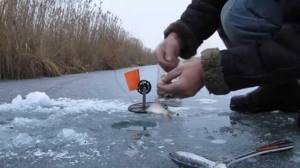
The fish come out to feed at about 8-00 in the morning, by this time it is worth doing all the preparatory work and installing the girders.
Advice ! half of the vents should be installed in shallow water, the rest in deep water. This way, you will get an idea of the presence of fish in this place.
Important! On lakes and ponds, girders are often placed near thickets of shore grass, along the shore. If the relief is a slope. Rails must be placed both at the beginning of the slope and at the bottom of the slope.
The vents are installed at a distance of approximately 10 m from each other.
Watch the video: How to catch pike on a girder in winter
Step-by-step practical fishing instructions
- Let's determine the bottom of the reservoir. The fishing line and sinker, mounted on a rig, are lowered into the water until the sinker comes into contact with the bottom. Having determined the full depth, it is necessary to shorten it by winding the fishing line to the height of the leash.
- It is better to first install the bait on the bottom of the reservoir and only if the live bait dies is it better to adjust the depth to half-water.
- After attaching the bait, turn the reel 2-3 turns to keep the bait above the vegetation and so that it cannot tangle the line.
- On warm days or days with low pressure, pike usually rise to a depth of half-water or to the very top.
- If there are no bites within 2 hours, the baits are moved to a distance of 20 meters from the previous one. If, on the contrary, the pike is actively biting in a given place, you should install the remaining girders at a distance of 2-3 meters and at the same depth.
- If the girder does not have a platform, and fishing takes place in snowfall, then it is better to cover the hole to avoid freezing. They also cover the hole in sunny weather so that the rays do not scare away the fish.
Features of hooking and fishing
Let's look at the secrets of successfully hooking and landing pike.
- Don’t do the hooking right away, it’s better to give the fish time to swallow the bait; if this doesn’t happen, when hooking, the fish will open its mouth and the bait with the fishing line will come out of it.
- After successful hooking, you need to hold the line with a slight tension. If the line weakens, the pike may swim into the snags and snag or tangle the line.
- If you pull the line too tightly, then it can rub against the sharp teeth of a predator or the edge of the ice.
- Fish weighing up to 1 kg can be pulled out of the hole without any problems. If the catch turns out to be heavier, then you can use a hook or bring the pike into the hole several times and it will come out into the hole on its own 5-6 times.
Advice! If the pike is large and there is a possibility that it might bite the line, then you can let the fish go a little without loosening the line, and then, on the contrary, slow down the fish by pulling the line towards you, then the line will move a little from the teeth towards the fish’s mouth and then you can drag it in, without fear that she will chew the fishing line. This way the pike moves easier and makes fewer strikes.
How to find “pike trails” - video
Selecting, buying, preparing and equipping a zherlitsa does not mean that you are ready to become a real zherlitsa. To increase the likelihood of catching a predator with this tackle, you need to know where and how to look for “pike trails.”

Tip #1. As soon as the ice has established itself and you can walk on it, it’s time to look for the toothed one in the shallower coastal areas of the reservoir. For example, it can sit in thickets, under snags and, of course, in the area of the drop from depth to shallow.
Tip #2. As soon as strong ice is established, pike food (small fish) loses activity and slides into holes, which means that you need to look for pike there. Therefore, in the middle of winter, experts advise looking for pikes in slopes near wintering pits.
Tip #3. If in the dead of winter nature spoils us with prolonged thaws, then the pike, following the food supply, moves to shallow places.
Tip #4. In winter, you are more likely to find pike in the area where streams and rivulets flow, where there are a lot of small fish in the fresh stream.
Tip #5. Snag, this particular place is considered one of the most interesting places for snag. If there are snags at the bottom, then sooner or later you can find pike there, provided that the oxygen regime there is not disturbed. On a large body of water, the snag, as a rule, also works in the dead of winter. However, when fishing in snags, be careful and always take a cutter with you when fishing.
For those who don’t want to read, we present a video on how to find “pike trails” and install girders on them.
Tips and tricks for catching pike in winter on girders
- Properly configured gear and skillfully choosing the habitat of pike is half the success of fishing.
- Studying the behavior of fish, its habitat, and the topography of the bottom of the reservoir is also a very important factor.
- It is better to fish with lures from the shore.
- For trolling, choose a short rod and thin line.
- The bait should not be bulky.
- It is better to play with bait 50 cm from the bottom.
- An echo sounder will help you probe the bottom and determine where the fish are located.
- You should walk on ice without making too much noise; fish are very sensitive to sounds.
- Fishing should be done in the morning after dawn and an hour before sunset.
- If you have several leashes, it is recommended to attach different live baits.
- If the river current is strong, it is better to use a heavier sinker.
- The hole is masked with snow.
- If you place several girders, there is no need to run from one to another.
Typical mistakes in catching pike on girders in winter
- They chose the wrong time for fishing, that is, the fish swims out in the morning starting at dawn, you can’t catch them during the day, but an hour before sunset the bite will begin.
- An uncovered hole will ensure no bite, the sun's rays will scare away the fish, it is better to camouflage the hole with snow.
- Let us remind you once again that going for pike in sunny weather will not yield results;
- The hook must be done, the fish must be allowed to swallow the bait, otherwise only the bait will remain on the hook;
- When fishing, you should not loosen the line too much;
- Behave quietly on the ice, don’t stomp or shout, you can scare away all the fish;
Fishing for pike in February using a spinning rod
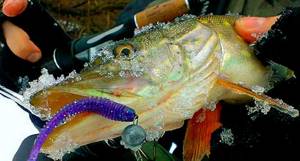
And yet, there is a nuance: if this February there is a lot of thaw, which is not uncommon in recent years, then the predator may slowly begin to switch to spawning behavior. Her instinct for procreation is already awakening, she begins to feed more in order to stock up on energy for spawning. On some days in February, trips with a spinning rod to a pond for pike can be very successful. Read also: Top 10 best budget wobblers for pike, How to catch pike in winter using a wobbler
The best results will come from using small silicone baits in bright colors. Although in February the pike’s instinct for procreation is already awakening, it is still moving slowly, since it has not yet gained strength after the winter period.
This is probably why the jig fishing method, which initially involves a leisurely step-by-step retrieve, brings the greatest success. Of course, other types of fishing should also be used. Luck is always on the side of anglers who like to experiment with baits and methods of fishing them. Considering the pre-spawning “moods” of pike, it can increasingly be found in shallow areas of rivers and lakes.
Pike fishing in February. Winter spinning video
RAGING, HUNGRY PIKE in February. PIKE on a wobbler 2017
Tips for advanced anglers
Fishing for pike on the edges
If you catch pike on the edges, then keep live bait at a depth of 10-50 cm from the bottom.
If fishing in a riverbed, the depth can be halved.
What to do if the slope is shallow?
If the slope is gentle, then let the bait fish sink to the depth, it is better if you know the depth and location of the holes, if not, you will have to probe the bottom experimentally.
Watch the video: Catching pike on a girder in winter
Fishing for pike in winter is exciting and will give you a lot of pleasure. However, you need to study the behavior of fish, fishing techniques and tactics, take into account weather conditions, choose the right place and the right equipment and girder, and then you will be rewarded with a great catch.
Design of the vent
The assortment of fishing stores includes many equipped options for supply, but it is better to take “naked” models, without fishing line and rigs. An experienced fisherman has his own opinion on the correct equipment of a winter fishing rod for pike. It differs in the diameter of the fishing line, the size of the hook and the type of leashes.
Structurally, the tackle consists of a plastic base, a reel holder, a reel and a flag. Most models are made in a round shape so that the tackle fits comfortably on the hole. It is less comfortable to fish with rectangular or square baits, especially at sub-zero temperatures.
To install the equipment on a medium-sized fish you will need:
- fishing line with a diameter of 0.3-0.35 mm;
- sliding sinker;
- rubber stopper or pellet;
- leash material;
- hook (single, double or triple).
Delicate tackle certainly increases bites, but the fish break off more often.
Line and leash
In winter fishing for girders, there is a simple rule: if fluorocarbon is used as a leash, the main line is doubled in thickness. As you know, only metal is resistant to the sharp teeth of a pike, and thick monofilament allows you to pull out the fish “roughly,” reducing the chances of being cut. The length of the leash should be at least 30 cm, since the tackle is often left unattended and a large specimen swallows the bait along with a short leash, cutting off the tackle. A popular option is tungsten twist - the material is quite dense and too tough for a pike. The main line is attached to the leash through a swivel, which prevents the bait fish from twisting the tackle.
Sinker
The lead weight holds the bait at a certain depth and is important when fishing in holes, channel edges and currents. The shape does not play a role, but streamlined models in the form of olives are mainly used. The sinkers are installed sliding and secured from below with a stopper or pellet. When biting, the predator does not feel the weight of the installation, since the load falls to the bottom, which allows the pike to calmly swallow the bait. In shallow water areas - bays and sandbanks - the tackle does not require additional weighting. Live bait behaves more naturally, its movements are not constrained.
To learn more:
Takedo: are their baits as good as they advertise?
Hook and bait for fry
The method of baiting fish through the gills is becoming increasingly popular. To do this, you need a double, which is located directly under the gill covers and is fastened with a carabiner. The hook is selected for live bait. A large one will pull the bait to the bottom and alert the predator.
With single and triple models, the fish is hooked by the lip, upper fin, and in some cases by the tail. Each method has its own advantages and disadvantages, but when biting, it is necessary to give the pike time to swallow the bait, otherwise there will be a disappearance.
